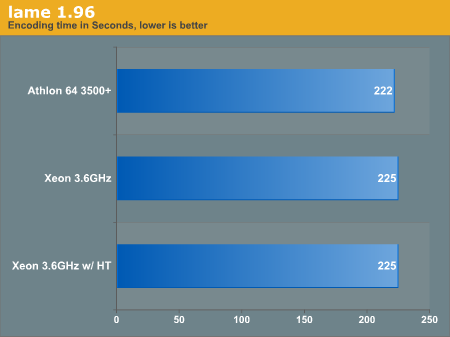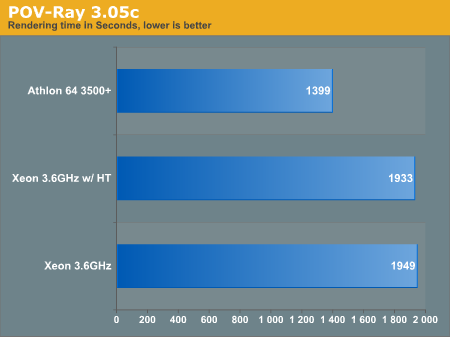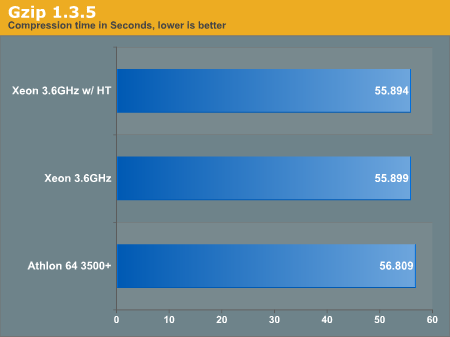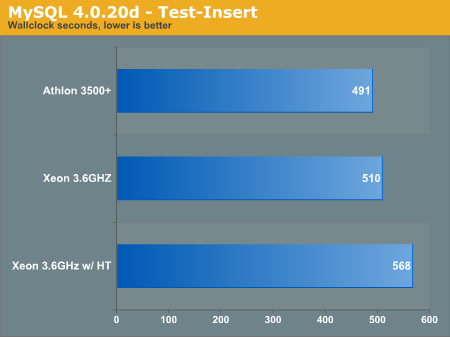Linux and EM64T; Intel's 64-bit Suggestion
by Kristopher Kubicki on August 9, 2004 12:05 AM EST- Posted in
- Linux
Audio Encoding
Lame was compiled from source without optimizations. We only ran ./configure and make, without any flags. We realize that some people would like to verify our binaries and sample files for their own benchmarks. In order to save bandwidth and prevent copyright infractions, we will provide our test files and binaries under limited circumstances to serious inquiries. We ran lame on a 700MB .wav file using the command equivalent to the one below:# lame sample.wav -b 192 -m s -h >/dev/null
Encoding time, lower is better.

POV-RAY
Although POV-RAY is limited in application (particularly when compared against Mental Ray), it does provide a free open source solution for basic rendering. POV-Ray 3.50c was our choice of render engine for this benchmark. For benchmark specifics, we run the exact benchmark as specified by the POV-Ray official site. We use the precompiled RPM for this test.Render Time in Seconds, less is better.

POV-Ray does not have multithread support, so we were not surprised to see the HyperThreading configuration slowing down to the configuration without HT. We see the Athlon 64 processor pull way ahead; render tasks are extremely CPU and memory dependant. With the memory controller on the CPU, Athlon 64 becomes the stronger offering in this situation.
GZip
To throw in some rudimentary tests for GZip, we used the included GZip 1.3.5 to compress the .wav file from the benchmark above. We do not want to limit our I/O on writing to the hard drive, so the operation is performed as below:# time gzip -c sample.wav > /dev/null

Intel wins their first bout of the analysis, albeit not by much. We will find a recurring pattern later on with integer based calculations and the Nocona Xeon processor. The entire Prescott family of Intel CPUs received a dedicated integer multiplier rather than continually using the floating point multiplier. This becomes extremely useful in some of our other benchmarks.
Database Performance
We will run the standard SQL-bench suite included with RPM MySQL 4.0.20d.

Of all our benchmarks, the SQL-bench becomes the most baffling. The extremely threaded database application performs particularly poorly with HyperThreading enabled. The Althon 64 outperforms Intel again in this benchmark, and a lot of it is almost certainly accredited to the on die memory controller again.
Update: We copied the 32-bit marks from our benchmark in previous testing instead of the 64-bit. You can view the previous articles here from a month ago. The graphs have also been updated.










275 Comments
View All Comments
Zebo - Thursday, August 12, 2004 - link
could acehardware have a worse forum tech? that's like 1995 BBS.JGunther - Thursday, August 12, 2004 - link
Don't mean to be a pest, but every moment that botched review is online is depressing. I'm looking forward to the new review as well. So where is this thing?tfranzese - Thursday, August 12, 2004 - link
About the Opteron vs. Xeon talk: Opteron scales better in SMP. Opteron is 8-way capable. And, I'd be willing to bet you Opteron will really stretch it's legs in 64-bit/64-bit once it's primetime, contrary to what I believe the Xeon will do - improve, but marginally.Aileur - Wednesday, August 11, 2004 - link
Tabajara - Wednesday, August 11, 2004 - link
I think that to call the reasoning of the author of this atticle as "nonsense" would actually be a compliment. Just take a look at the conclusion that someone thinking straight would get, using tha same info that is on the article:"In spite of the fact that this Xeon processor retails for $850 and the Athlon 3500+ retails for about $500 less, that this Xeon does not even exist in retail channels yet, that the AMD processor is clocked 1400MHz slower than the 3.6GHz Xeon and has 512 less kb of cache, IT STILL WINS MOST OF THE REAL WORLD TESTS!"
Another important factor: the price and performance difference of the mobos used for each processor probably gives the P4 an edge. To use a NVIDIA NForce3 250 Reference Board against a SuperMicro Tumwater X6DA8-G2 is just not fair.
Other caractheristic that makes this review resemble the ones done at the POS THG is that the synthetic benchmarcks seem to have been picked to benefit a CPU that has a higher clock and that excels at handling branching instructions (as chess based bechmarks, that have to calculate lots of possible moves). In other words, tests that show the best qualities of the P4.
Viditor - Wednesday, August 11, 2004 - link
KK - "yeah the review is done just pushing it live as soon as i can"You da man Kris! Now may I suggest you turn off the damn computer and go enjoy what's left of your vacation!!!!
Cheers,
Charles
snorre - Wednesday, August 11, 2004 - link
Kristopher: Read this:http://www.aceshardware.com/forum?read=115094123
You should also test Crafty.
KristopherKubicki - Wednesday, August 11, 2004 - link
Not really sure what the fuss is about the remote server? Its at Jason's place, SuperMicro gave it to him. You can email him about it if you like.Anyways, yeah the review is done just pushing it live as soon as i can. I think you will enjoy these benches much better.
-MySQL
-Postgress
-MentalRay
-Povray
-TSCP
-gzip
-mencoder
-lame
-JTR again but a different source - the AMD and Intel optimizations are highlighted as we compiled the code
-One synthetic benchmark
-Anything else i can think of in the next 20 min that is quick to test.
anything we compiled was done using -o2 and unroll-loops.
snorre - Wednesday, August 11, 2004 - link
Time's Up!snorre - Wednesday, August 11, 2004 - link
Correction, still about 20 minutes to go :PPrepare to be scrutinized, so this new review better be flawless ;-)